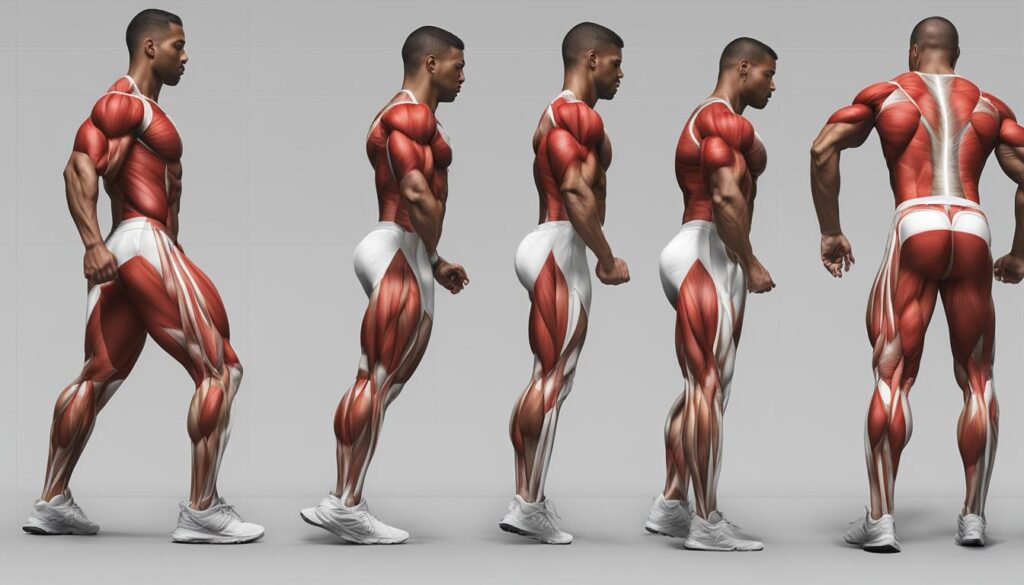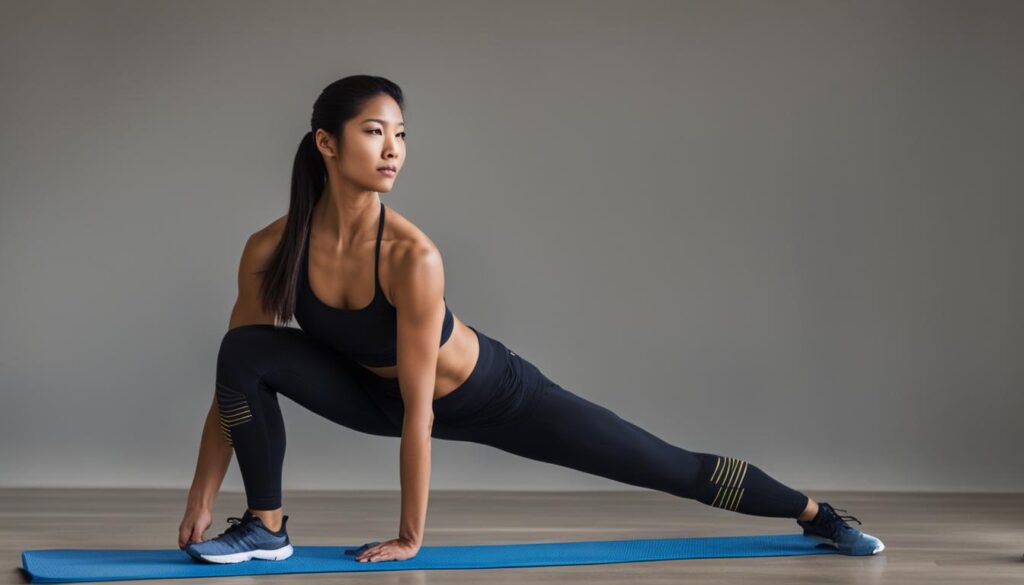If you’re looking to develop a well-rounded workout routine that enhances both strength and flexibility, incorporating hamstring exercises is a must. The hamstrings are essential for overall lower body stability, athletic performance, and injury prevention.
By dedicating time to specifically target the hamstring muscle group, you can improve the strength and mobility of this area, leading to better overall fitness and athletic performance.
Key Takeaways:
- Including hamstring exercises in your workout routine can enhance lower body stability, athletic performance, and injury prevention.
- Targeting the hamstrings helps to improve the strength and mobility of this muscle group.
- By dedicating time to specific exercises that target the hamstrings, you can achieve a well-rounded workout that enhances both strength and flexibility.
- It’s important to join with a fitness professional or trainer to ensure appropriate form and technique in performing these exercises.
- Dynamic warm-up exercises, isolation exercises, compound exercises, plyometric exercises, flexibility exercises, and injury prevention and rehabilitation exercises are effective exercises to strengthen and improve the flexibility of the hamstrings.
Importance of Strong Hamstrings in Fitness Training
Before diving into the top hamstring exercises, it is essential to understand the crucial role strong hamstrings play in fitness training. The hamstrings consist of three muscles located on the back of the thigh – the biceps femoris, semitendinosus, and semimembranosus. These muscles are responsible for essential movements like running, jumping, and squatting. By developing strong hamstrings, you provide stability and support to the knees and hips, preventing injuries and optimizing athletic performance.
Incorporating hamstring exercises into your fitness routine is imperative for a well-rounded workout, ensuring you don’t neglect this vital muscle group. By performing hamstring exercises, you can increase flexibility, strength, and stability in the lower body, leading to better athletic performances.
If you have weak hamstrings, you might experience issues such as knee pain, limited motion, and decreased athletic ability. Thus, it is crucial to focus on hamstring development for optimal fitness levels.

Before diving into the top hamstring exercises, it is pertinent to understand the importance of strong hamstrings in overall fitness training. The table below showcases the primary benefits of strong hamstrings.
| Benefits of Strong Hamstrings |
|---|
| Prevents knee injuries, such as ACL tears |
| Improves athletic performance, including jumping and running ability |
| Helps maintain correct posture |
| Enhances balance and stability |
| Improves overall lower body strength |
Clearly, there are various reasons why strong hamstrings are essential in fitness training. By incorporating exercises that help strengthen and develop the hamstrings, individuals can improve their athletic performance, reduce the risk of injury, and enhance overall fitness levels.
Understanding the Hamstring Muscle Group
When it comes to achieving optimal lower body strength and stability, the hamstrings play a crucial role. The hamstring muscle group is located in the back of the thigh and is primarily responsible for knee flexion and hip extension. The group of muscles works closely with the quadriceps to provide balance and stability to the lower body, making them essential for daily activities like walking, running, and jumping.
Targeting the hamstrings with specific exercises can help you strengthen and improve their flexibility, leading to better athletic performance and a reduced risk of injury. Incorporating hamstring exercises into your workout routine can also help to prevent imbalances and promote overall lower body health.

Key Points:
- The hamstring muscle group is responsible for knee flexion and hip extension.
- Working in conjunction with the quadriceps, the hamstrings provide balance and stability to the lower body.
- Targeted hamstring exercises can help you strengthen and improve flexibility in this essential muscle group.
Dynamic Warm-Up Exercises for the Hamstrings
Before taking on intense exercises, it is crucial to warm up your body and muscles. Dynamic warm-up exercises targeting your hamstrings can improve blood flow, increase muscle elasticity, and reduce the risk of injury. Incorporate the following 3 dynamic warm-up exercises into your routine to prepare your hamstrings for your workout:
1. Leg Swings
Stand on your right leg and swing your left leg back and forth keeping it straight. Then repeat on the other side. Do 10 swings on each leg.

2. Inchworms
Start in a standing position, hinge at the hips and reach down to touch your toes. Walk your hands out until you’re in a plank position, then slowly walk them back to your feet. Do 10 reps.
3. High Knees
Stand on one leg and lift the opposite knee toward your chest as high as possible, then switch and repeat. Do 20 reps total for each leg.
Isolation Exercises for Hamstring Strength
Isolation exercises are great for developing targeted strength in the hamstrings. By exclusively targeting the hamstring muscles, these exercises allow for optimal muscle activation and improved hamstring strength. Including isolation exercises in your workout routine can optimize your overall lower body strength and performance.
Here are some effective isolation exercises that you can add to your workout routine to specifically target your hamstrings:
| Exercise | Description |
|---|---|
| Hamstring Curl Machine | This machine targets only hamstrings and allows for maximum resistance and isolation. Lie down on the machine with your thighs resting on the padded surface. Keep your back flat and curl your feet towards your buttocks. |
| Romanian Deadlift | This exercise targets the hamstrings as well as the glutes, hips, and lower back. Stand upright with your feet shoulder-width apart and a barbell in front of you. Keeping your back straight, hinge at the hips and lower the bar down your thighs as far as you can go before feeling discomfort, then push back up to starting position. |
| Single-Leg Deadlift | This exercise targets one leg at a time in a similar way to the Romanian Deadlift, but with increased focus on hamstring strength. Stand on one leg with your opposite foot slightly behind you and a dumbbell in the hand opposite to the standing leg. Keeping your back straight, hinge at the hips and lower the dumbbell towards the ground while lifting your opposite leg out behind you. Return to starting position and repeat on the opposite side. |
Adding isolation exercises like these to your workout routine can help you achieve your desired hamstring strength and performance goals.

Compound Exercises for Hamstring Development
Compound exercises are a great way to target the hamstrings while also engaging other major muscle groups in the lower body. These exercises stimulate multiple muscle fibers simultaneously, promoting overall strength and functionality. Here are the top compound exercises that help develop strong and powerful hamstrings:
| Exercise | Primary Muscles Worked |
|---|---|
| Deadlifts | Hamstrings, glutes, lower back |
| Squats | Hamstrings, quadriceps, glutes |
| Lunges | Hamstrings, quadriceps, glutes |
| Step-Ups | Hamstrings, quadriceps, glutes |
Compound exercises such as these should be incorporated into your routine at least once a week for optimal hamstring development. They are versatile and can be modified to meet individual fitness levels and goals. Keep in mind that proper form and technique are paramount when performing compound exercises to avoid injury and maximize results.
Plyometric Exercises for Explosive Power
Want to increase your explosive power and take your athletic performance to the next level? Incorporating plyometric exercises into your workout routine can help you achieve just that. Plyometric exercises focus on quick, powerful movements that engage the fast-twitch muscle fibers in your hamstrings, helping you develop explosive speed, agility, and jumping ability.
Some effective plyometric exercises for hamstring strength include jump squats, box jumps, and lunge jumps. These exercises require you to quickly and powerfully jump or lunge and land safely on both feet, engaging and activating your hamstring muscles. By including plyometric exercises in your routine, you can enhance your overall performance and build impressive hamstring strength.
Jump Squats
Jump squats are a highly effective plyometric exercise that targets your hamstrings, glutes, and quadriceps muscles. To perform this exercise, stand with your feet shoulder-width apart and lower your body into a squat position. Quickly jump upwards, pushing off with your feet and lifting your arms overhead. Land safely on both feet and repeat. Try to complete three sets of 10 reps.
Box Jumps
Box jumps are another popular plyometric exercise that can help develop impressive hamstring strength. To perform this exercise, stand in front of a sturdy box or platform. Lower your body into a squat position and quickly jump onto the box, landing safely on both feet. Step back down and repeat. Try to complete three sets of 10 reps.
Lunge Jumps
Lunge jumps are a challenging plyometric exercise that require coordination and balance. To perform this exercise, start in a lunge position with your right foot forward and left foot back. Lower your body into a lunge position and quickly jump upwards, switching your feet mid-air to land with your left foot forward and right foot back. Repeat, alternating between right and left foot forward. Try to complete three sets of 10 reps on each leg.
Flexibility Exercises for Hamstring Mobility
To maintain optimal hamstring health, it’s important to prioritize flexibility exercises in your workout routine. Flexibility exercises improve your range of motion and reduce the risk of injury by preventing muscular imbalances. Here are some effective hamstring flexibility exercises:
- Hamstring Stretch: Lie on your back and lift one leg straight up, holding onto your ankle with both hands. Gently pull your leg towards your chest until you feel a stretch in your hamstring. Hold for 30 seconds and repeat on the other leg.
- Dynamic Leg Swings: Stand facing a wall with your hands on the wall for support. Swing one leg forward and backward, keeping it straight. Repeat for 10 reps on each leg.
- Downward Dog: Begin in a plank position with your hands and feet on the ground. Lift your hips up and back, creating an inverted V shape. Hold for 30 seconds and repeat.
Incorporating these exercises into your workout routine can improve your overall hamstring mobility and enhance your athletic performance.
Injury Prevention and Rehabilitation Exercises for the Hamstrings
Injuries to the hamstrings are common among athletes and individuals with weak or tight muscles. Fortunately, there are various exercises that can help prevent such injuries, and aid in rehabilitation in case of an injury. By incorporating specific exercises that target the hamstrings, you can improve their strength, flexibility and overall mobility.
Prevention Exercises
Some of the best injury prevention exercises for the hamstrings include:
| Exercise | Description |
|---|---|
| Single-Leg Deadlift | This exercise strengthens the hamstrings and improves balance. Stand on one leg while holding a weight or kettlebell in the opposite hand, hinge at the hips and lower your torso, extending your free leg behind you. |
| Glute Bridge | This exercise strengthens the core, glutes, and hamstrings. Lie on your back, bend your knees, and place your feet hip-width apart on the floor. Raise your hips as high as possible while squeezing your glutes and keeping your abs tight. |
| Bridging | This exercise strengthens the hamstrings and improves hip extension. Lie on your back with your knees bent and feet on the floor. Lift your hips off the ground by pressing your feet into the floor and squeezing your glutes. |
Note: Perform these exercises with proper form, and gradually increase the intensity and resistance over time to avoid creating new injuries.
Rehabilitation Exercises
If you’ve suffered a hamstring injury, it is important to have a tailored rehabilitation plan in place. Some effective rehabilitation exercises include:
- Lying hamstring stretch: Lie on your back, bend one leg while keeping the foot planted on the ground, raise the other leg and grab onto it with your hands. Pull it towards your torso, keeping your knee extended, and hold the stretch for 15-30 seconds before switching legs.
- Seated hamstring stretch: Sit on the floor with both legs extended in front of you. Reach for your toes with your hands, keeping your back flat and your legs straight. Hold the stretch for 15-30 seconds and repeat for several rounds.
- Hamstring curls: Lie down on your stomach with your knees slightly bent. Start by flexing one leg and slowly bringing your heel towards your buttocks, holding it for 5 seconds. Release, and then repeat with your other leg.
Note: Rehabilitation exercises should be performed under the guidance of a medical professional or trainer, and only after your injury has sufficiently healed.
By incorporating targeted injury prevention and rehabilitation exercises into your workout routine, you can improve hamstring strength and mobility, reduce the risk of injuries, and promote faster healing in case of injuries. However, always ensure proper form, intensity, and progression, under the guidance of a qualified professional.
Training Frequency and Program Design for Optimal Hamstring Development
Training frequency and program design play a crucial role in achieving optimal hamstring development. To ensure steady growth and improvement, it is essential to incorporate hamstring exercises into your fitness regimen consistently. The recommended training frequency for hamstring workouts is at least twice per week, and for intermediate and advanced trainers, up to three or four times per week. Ensure adequate rest time between workouts to prevent overtraining and injury.
Program design should include a variety of exercises that target different areas of the hamstring muscle group, including isolation and compound exercises for strength development, as well as plyometric exercises for explosive power and flexibility exercises for mobility. Incorporate dynamic warm-up exercises at the start of your routine to prepare the muscles for intense exercise. Gradually increase the intensity and volume of your workouts over time to progressively overload the muscles for continuous growth.
“Consistency is key when it comes to hamstring development. Incorporate a combination of exercises into your training program at least twice a week and gradually increase the intensity and volume over time for optimal results.”
Conclusion
Now that you have learned about the importance of strong hamstrings in your fitness training, as well as the top hamstring exercises to incorporate into your routine, it’s time to get started. Remember to warm up properly with dynamic warm-up exercises and gradually increase the intensity of your workouts.
When performing isolation and compound exercises, focus on proper form and technique to prevent injury and optimize muscle activation. Don’t forget to add plyometric exercises for explosive power and flexibility exercises for improved range of motion.
To prevent hamstring injuries and aid in rehabilitation, incorporate injury prevention and rehabilitation exercises into your routine. Lastly, to achieve optimal hamstring development, follow a well-designed program that progressively overloads the muscles and allows for appropriate training frequency.
Remember to consult with a fitness professional or trainer if you have any questions or concerns about incorporating these exercises into your routine. With dedication and consistency, you can achieve a well-rounded workout and improve your athletic performance.
FAQ
What are the top hamstring exercises for a well-rounded workout?
The top hamstring exercises for a well-rounded workout include deadlifts, lunges, hamstring curls, and glute bridges.
Why are strong hamstrings important in fitness training?
Strong hamstrings are important in fitness training because they provide stability and support to the knees and hips, preventing injuries and improving athletic performance.
What are the muscles that make up the hamstring muscle group?
The hamstring muscle group consists of the biceps femoris, semitendinosus, and semimembranosus muscles.
What are dynamic warm-up exercises for the hamstrings?
Dynamic warm-up exercises for the hamstrings include walking lunges, high knees, and leg swings.
What are isolation exercises for hamstring strength?
Isolation exercises for hamstring strength include hamstring curls, glute-ham raises, and Romanian deadlifts.
What are compound exercises for hamstring development?
Compound exercises for hamstring development include squats, deadlifts, and lunges.
What are plyometric exercises for explosive power in the hamstrings?
Plyometric exercises for explosive power in the hamstrings include box jumps, jump lunges, and medicine ball slams.
What are flexibility exercises for hamstring mobility?
Flexibility exercises for hamstring mobility include standing hamstring stretches, seated forward bends, and lying hamstring curls.
What are injury prevention and rehabilitation exercises for the hamstrings?
Injury prevention and rehabilitation exercises for the hamstrings include hamstring eccentric exercises, hip extensions, and single-leg deadlifts.
How often should I train the hamstrings for optimal development?
For optimal hamstring development, it is recommended to train the hamstrings 2-3 times per week.
How can I design a program for optimal hamstring development?
When designing a program for optimal hamstring development, it is important to incorporate a variety of exercises, progressively increase intensity, and allow for adequate rest and recovery.
Is it necessary to consult a fitness professional for proper form and technique?
It is highly recommended to consult a fitness professional or trainer to ensure proper form and technique when performing hamstring exercises to prevent injuries and maximize results.


Leave a Comment